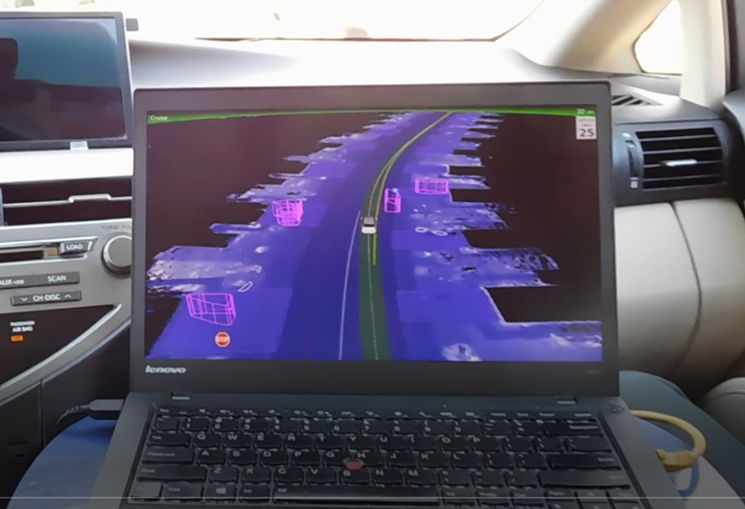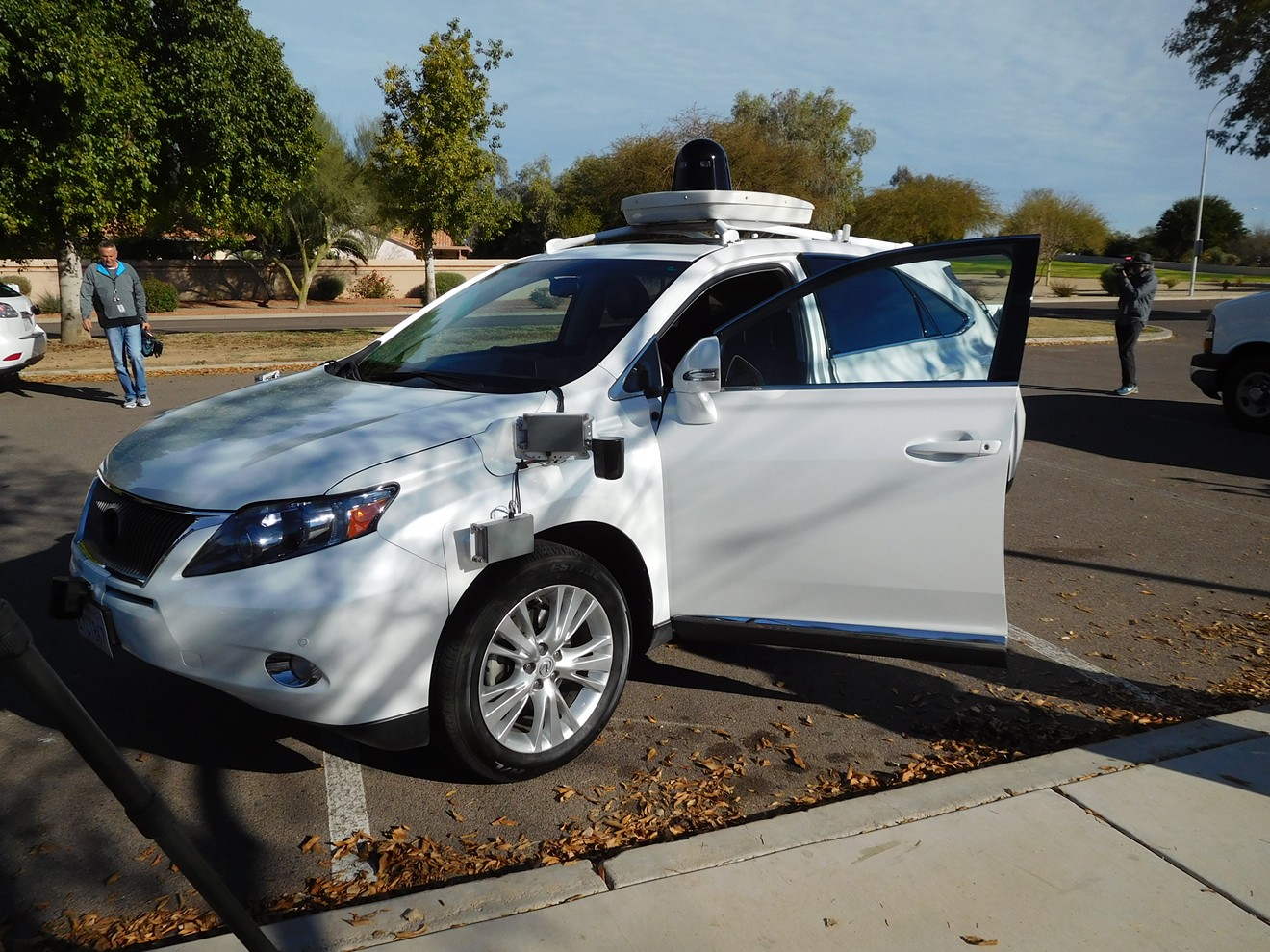What to do? The city truck was only going 15 mph, below the 25 mph posted speed limit, but took up most of the lane. The Lexus SUV hybrid – driven solely by a computer — would not enter the yellow-striped turn lane to pass. Nearly a minute later, the street sweeper pulled off to the right, allowing the self-driving vehicle to get around. A busy soccer mom would likely not have waited nearly as long, taking the risk of passing.
The encounter was one of the more interesting moments during New Times’ ride on Thursday in the vehicle outfitted and turned pilotless by Waymo, the Google spinoff company that’s been testing self-driving vehicles in Chandler since April. Laxer regulations, plus the area’s famous dust storms and hot weather to challenge the vehicles, have been cited as reasons for opening an office in Chandler.
Fortunately for the company, its project hasn’t had anything too exciting occur: So far, company representatives and city officials say, the vehicles haven’t caused any collisions or otherwise embarrassed the company or city. Even Governor Doug Ducey, who invited Uber’s autonomous-vehicle division to Arizona after it failed to obtain proper certification in California, has ridden in a Waymo safely.

Waymo's 3D imagery recreates the world around it, allowing it to see objects with a superhuman 360-degree field of view.
Ray Stern
The vehicles promise to usher in a world in which people can get more work done – tapping away on their laptops in the backseat, more comfortable in their artificially intelligent, wheeled cocoon than a subway commuter ever could be.
Tragic highway deaths would become rare, allowing vehicles to be made of lighter materials that use less fuel than anything now on the road.
Family members could share vehicles, which would be summoned like robots to pick up and drop off people, spending spare time on a charging pad that provides its electricity. The first generation of this sci-fi scenario, a reasonably-priced product for the commercial market, is just a few years away — that's how Waymo sees things shaping up, anyway.
New Times agreed not to quote any of the employees directly to be allowed to participate in the demonstration, but was permitted to use information they offered, attributable in general to the company.
Waymo is one of several rushing to deliver autonomous vehicles to the marketplace, but a big obstacle has been the cost. Google acknowledged in 2012 that its Lexus vehicles were covered in $150,000 worth of electronics.
The expensive-looking hardware can't be missed when approaching the Lexus. Black, bell-shaped LIDAR units are mounted in four places around the SUV. LIDAR stands for light detection and ranging: the devices use lasers to find the distance to objects and create a computer-generated 3D image of the SUV's surroundings that's displayed on a laptop inside.
Eight small, gray boxes housing radar equipment also surround the vehicle's exterior, each with its own fan to help keep it cool. A basketball-sized black bubble on the Lexus' roof contains more LIDAR, plus cameras that help the vehicle's powerful on-board computer avoid obstacles. The system also uses GPS technology and street information provided by the city of Chandler to help reduce the chance of a foulup.
Costs may be coming down soon, though. Waymo CEO John Krafcik announced at the North American International Auto Show in Detroit this week that the company had figured out a way to produce LIDAR systems for one-tenth the cost.

Waymo Lexus interior. The big red button does what you may think — it's one way to stop the vehicle's autonomous function.
Ray Stern
On Thursday, vehicle operation specialist Amanda Sultan sat behind the wheel, though she didn't use it to control the vehicle at any point in the 15-minute drive. Another test driver, Marcus Estrom, rode shotgun with the laptop open on his lap. The 3D imagery shows the system’s impressive, 360-degree view, its sight capturing most everything within hundreds of feet, all around.
Directly beneath the gear shifter is a prominent red button that looks as though it came from a 1950s movie. As expected, it turns out that the button cuts off the Lexus' autonomous operation. Grabbing the wheel or hitting the brake does that, too.

The LIDAR unit on the vehicle's roof also houses several cameras that help the Lexus see its surrounding.
Ray Stern
In 2015, operators inside the vehicles took control just less than once every 1,000 miles. Now it reportedly occurs one-fourth as much.
Waymo vehicles have logged about 3 million miles in their eight years of operation, starting in California as Google self-driving cars, with relatively few problems. A monthly report from August 2016 available online relates three Chandler collisions that weren't Waymo's fault. Two involved Waymo cars being rear-ended, while another was hit by a red-light runner.
The Waymo Lexus drove perfectly – almost annoyingly so. It ran at a constant 44 to 45 mph in a 45 mph zone, usually holding to the right-most lane unless it needed to go left. During a right-hand turn in a residential neighborhood, the Lexus entered an unoccupied bicycle lane about 50 feet before the turn.
The vehicles are programmed to operate in California, where vehicles must enter bike lanes prior to turning right, although in Arizona the law requires motorists to make right turns from the right-most lane when possible, and that would include the bicycle lane. So the Waymo is better than most drivers in by-the-book driving. The Lexus soon returned to its starting point at the park.
Waymo has no answer for who would be responsible and how driver responsibility would work in a future in which no one sat near a self-driving car’s controls. In a totally autonomous vehicle with no test driver, it's unclear how justice would be served in what would presumably be the rare case of a vehicle going berserk and causing death or injury. Even if statistics eventually prove autonomous vehicles are safer than human-driven ones, will the public accept them and the new culture they may bring?
For now, someone must sit in the driver's seat under Arizona law, officials say, and that means if the Lexus injured someone while driving with New Times and the vehicle was found to be at fault, Sultan could be held responsible.
"There's still somebody behind the wheel," says Matt Burdick, spokesman for the City of Chandler. "They're still responsible for the operation of that vehicle. They can take over control of the vehicle at any point."
Chandler helped ensure the safety of the vehicles directly, he says, by augmenting the company’s maps of the area.
"We've assisted them to get details in terms of what they're going to encounter if they're going to travel on streets," he says. "Curb heights, utility boxes – different things to develop detailed maps."
The city hasn't made any money on Waymo, nor paid anything to the company, he says, but city officials and residents have an "openness" to Waymo.
"The support they've received has allowed them to grow and progress this effort," he says.













